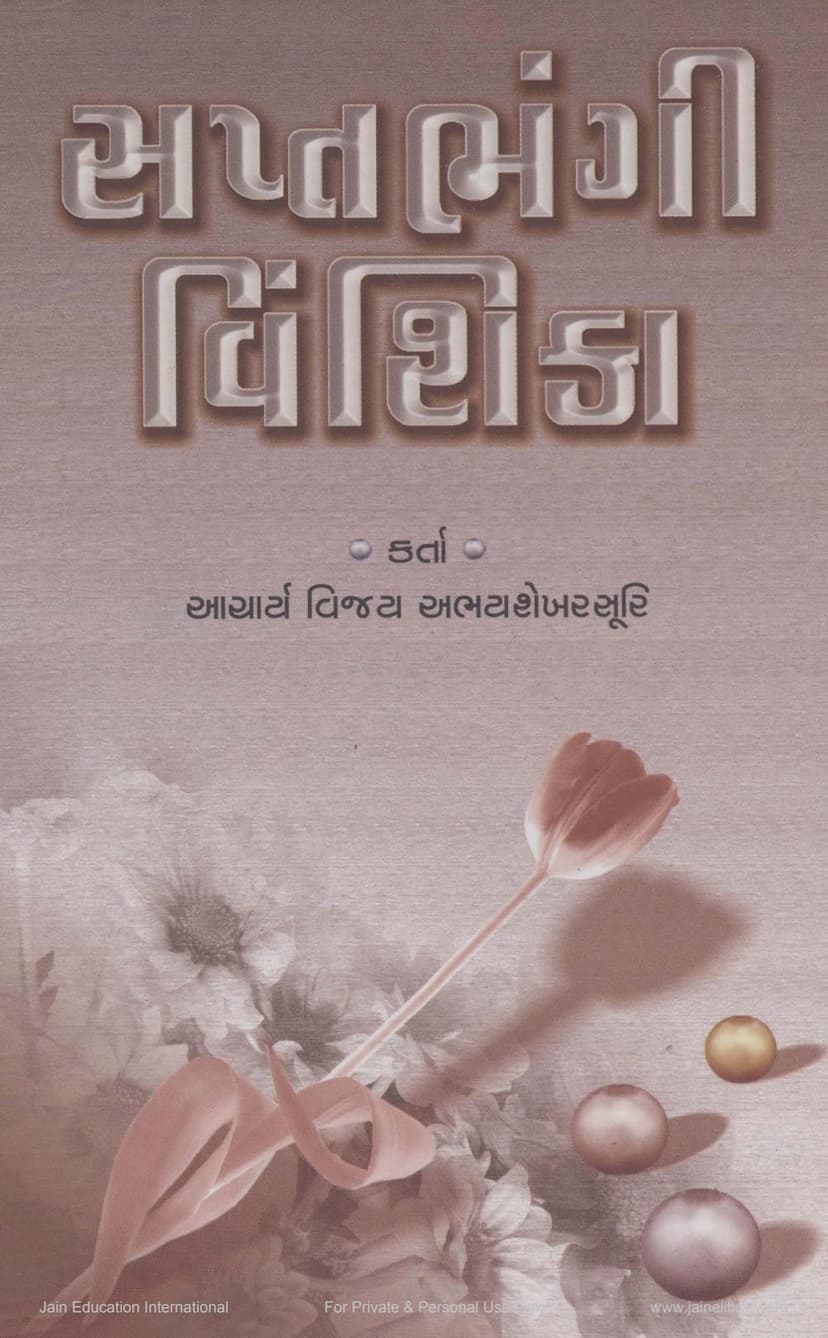Saptabhangivinshika
Added to library: September 2, 2025

Summary
The provided text is a Jain religious and philosophical book titled "Saptabhangi Vinshika" (સપ્તભંગી વિંશિકા) authored by Acharya Vijay Abhayshekharsuri. The book, published by Divya Darshan Trust, delves into the complex Jain doctrine of Syadvada (સ્યાદ્વાદ), specifically focusing on the Saptabhangi (સપ્તભંગી) – a seven-fold logical system used to describe reality from multiple perspectives.
Here's a comprehensive summary of the key aspects covered in the text:
Core Theme: Syadvada and Saptabhangi
- Syadvada (સ્યાદ્વાદ) is presented as a victory mantra, making the follower invincible in discussions and arguments. It's described as the antidote to rigid thinking (kadagraha) and the poison of absolutism (ekantavada). It guides one to the peak of truth.
- Saptabhangi (સપ્તભંગી) is the soul of Syadvada and a treasure trove of Jain philosophy. It's a method of predication that uses seven possible modes of affirmation and negation to describe any given subject. The book aims to shed light on its brilliance, which had been obscured.
The Author and the Book:
- Acharya Vijay Abhayshekharsuri is the author, a profound thinker and scholar from the Tapagachha lineage, disciple of Acharya Vijay Prem-Bhuvana Bhanu-Dharmjit-Jay Shekhar Suri.
- Saptabhangi Vinshika (સપ્તભંગી વિંશિકા) is a new work by the Acharya, adorned with his own commentary (swopadnya vritti) and a Gujarati explanation (gujar grahana vivechan). The title "Vinshika" suggests it contains twenty verses in Sanskrit.
- The book was published by Divya Darshan Trust and is dedicated to the memory of the author's guru, Acharya Vijay Jayashekhar Suri.
Key Philosophical Discussions within the Book:
- The Number Seven (सप्तैव भङ्गाः): The book addresses why there are precisely seven logical propositions in Saptabhangi and not fewer or more. It argues that this number corresponds to the seven types of inquiries and questions that can arise about reality.
- The Nature of Saptabhangi: Each proposition in Saptabhangi begins with "Syat" (स्यात् - perhaps/in a certain way) and often ends with an affirmative or negative assertion. The author emphasizes how Syadvada is reflected in each proposition.
- The Third Proposition ("Syad Avaktavya"): A significant portion of the book is dedicated to the third proposition, "Syad Avaktavya" (स्यादवक्तव्य - perhaps indescribable). The author clarifies the distinction between "avaktavya" (indescribable) and "anabhilapya" (unutterable) as used in Jain scriptures.
- Distinction between Nouns and Concepts: The text explores the philosophical nuances of words like "Pushpadanta" (पुष्पदन्त) which refers to both the sun and the moon, and "Hari" (हरि), referring to Vishnu, Indra, and a lion, discussing how single words can represent multiple entities and how these are understood through context and scriptural interpretation.
- Arthaparyaya vs. Vyanjanaparyaya: A crucial distinction is made between two types of paryaya (modes/attributes):
- Arthaparyaya (अर्थपर्याय): These are attributes that have a functional purpose (arthakriyakaritva) and contribute to the substance's overall form. They are considered inherent parts of the substance's true nature.
- Vyanjanaparyaya (व्यञ्जनपर्याय): These are attributes related to the naming or labeling of a substance. They are understood as conventional, based on designation or convention (sanketa). The author argues that Vyanjanaparyayas are not essential to the substance's core reality and are not functionally significant in the same way as Arthaparyayas. The book spends considerable time explaining why Vyanjanaparyayas have only two relevant propositions in Syadvada, while Arthaparyayas have seven.
- The Role of Context and Intention: The author highlights how the meaning and application of Syadvada propositions depend heavily on the context, the intention of the speaker, and the understanding of the listener. The distinction between "ignorance" (leading to the need for Sanketa) and "knowledge" is explored.
- The Indescribable (Avaktavya): The text argues that the third proposition, "Syad Avaktavya," is necessary because sometimes a question involves multiple attributes of a substance where some are its true nature ("swa" - own) and others are external ("para" - other) in relation to the context of the inquiry. When both are considered together in a single question and require a single answer, the situation becomes indescribable by simple affirmation or negation.
- Reconciling Different Philosophical Viewpoints: The author engages with other philosophical schools (like Nyaya) and discusses how Syadvada can accommodate or refute their positions.
- The Author's Contribution: The book is noted for its depth, clarity, and original insights into the Saptabhangi doctrine, going beyond mere recitation of previous commentaries. It's seen as a new revelation (navsarjan) that illuminates previously obscure aspects of the doctrine.
Supporting Elements:
- Praise for Gurus: The text contains extensive praise and tributes to the author's lineage of gurus, highlighting their virtues and contributions to Jain scholarship and practice.
- Dedication: The book is dedicated to the author's guru, Acharya Vijay Jayashekhar Suri.
- Publisher and Donors: The publication is supported by the Divya Darshan Trust and acknowledges the contributions of the Shri Jain Shwetambar Murtipujak Sangh, Miraj.
In essence, "Saptabhangi Vinshika" is a scholarly work that meticulously breaks down and explains the Saptabhangi doctrine, emphasizing its logical coherence, its philosophical underpinnings (especially the distinction between Arthaparyaya and Vyanjanaparyaya), and its author's unique contributions to its understanding. It is presented as a guide for sincere seekers of truth within Jainism.